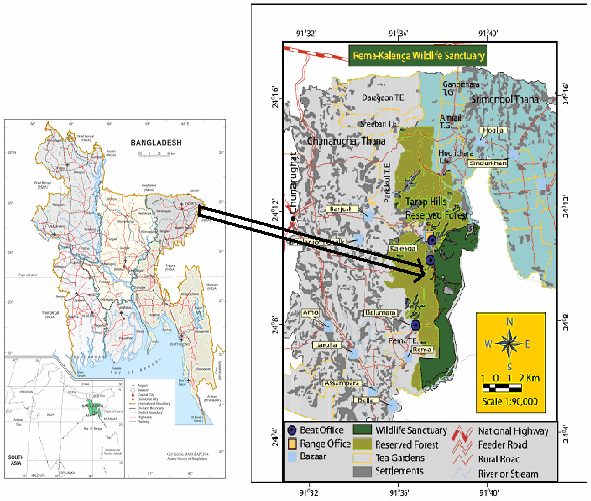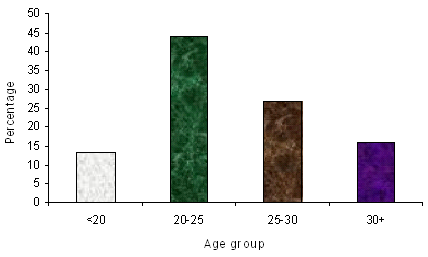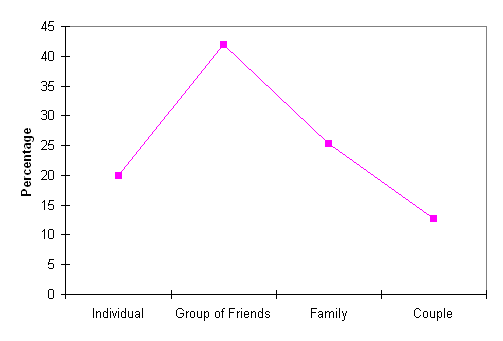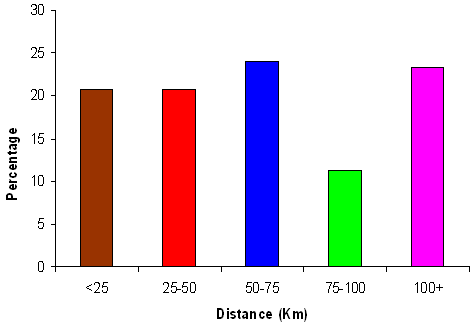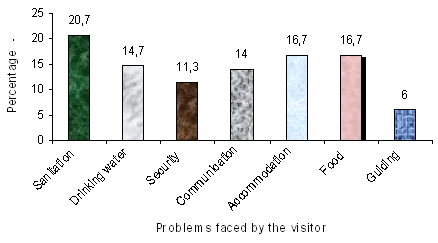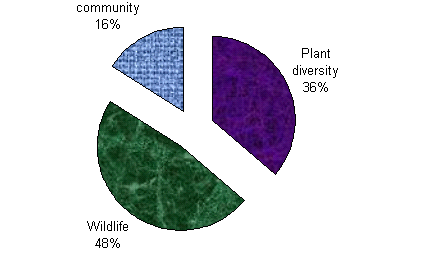
Implications of ecotourism development in protected areas: a study from Rema-Kalenga Wildlife Sanctuary, Bangladesh
iForest - Biogeosciences and Forestry, Volume 3, Issue 1, Pages 23-29 (2010)
doi: https://doi.org/10.3832/ifor0520-003
Published: Jan 22, 2010 - Copyright © 2010 SISEF
Research Articles
Abstract
This article is based on visitors profile study of protected area based tourist spots of Rema-Kalenga Wildlife Sanctuary (RKWS), Bangladesh to ascertain the potential of ecotourism. Study findings shows that 69% male constitute the visitors group while the maximum number of visitors was found in the age of below 30 years. Most of the visitors were literate and among them 43% visitors were student. Most (53%) of visitors preferred to get recreation in holidays as they were employed. Visitors were highly preferred to come with friends group. About 92% respondents showed positive mind to come here in future while 89% respondents view that park has tourism potential. Most of the respondents reported the presence of wildlife (48%) most notable followed by plant diversity and tribal community as recreational. From χ2 test it is found that highly significance association present between tourism potentiality of the wildlife sanctuary and some demographic variable like income of tourists (χ2 = 49.138, p < 0.000), visiting pattern (χ2 = 19.344, p < 0.000), education of tourists (χ2 = 50.226, p < 0.000), travelling distance (Km - χ2 = 11.427, p < 0.022), duration of staying (χ2 = 12.867, p < 0.002), frequency of visit (χ2 = 8.456, p < 0.015), visiting time (χ2 = 6.530, p < 0.011), problem in the study area (χ2 = 14.962, p < 0.021), occupation of tourists (χ2 = 8.848, p < 0.031). If the problems addressed by the visitors were solved, RKWS would be a bright place of eco-tourism in Bangladesh.
Keywords
Ecotourism, Protected area, Tourism potential, Visitors, Bangladesh
Introduction
Worldwide, many countries and regions rich in biodiversity and poor in economy have been vigorously promoting ecotourism as a conservation tool in their protected areas (PAs) since the 1990s ([17]). PAs now cover more than 12% of the world’s land area. These PAs are on the front line in the campaign to conserve biodiversity as well as to promote eco-tourism on the planet Earth ([8], [15]). Tourism use of PAs basically involves the travel for the discovery and learning about wild environments. The importance of nature in attracting tourists is significant and stated that nature and cultural heritage represent a competitive advantage for many areas, for different kinds of protected areas ([40]), a chance to see wildlife and undisturbed nature is rated as very important reason for visits to PAs ([14]). PAs are becoming more popular destinations for wildlife tourists of national and international origin. Besides this, economic benefits from tourism are observed in different PAs. Protected area based eco-tourism that can give rise to economic benefits to local communities as well as to the nation ([15], [14], [37], [39], [16], [12], [13], [11], [18], [23], [29], [22], [35], [36]). Nature or forest based tourism is a key category of eco-tourism, one of the fastest growing sectors of the world ([21]). However in Bangladesh this promising sector is poorly utilized. From a source it has been found that, less than 10000 foreign visitors entered in 1992, domestic tourism on the other hand appears to be a strongly flourishing sector of the market ([34]).
Protected areas have played significant roles as tourist attractions in many countries since their establishment ([6]). PAs with their landscapes, flora and fauna as well as their cultural elements form attractions for tourists ([7]). Another thing is that eco-tourism continues to become a management strategy for protected areas. There are numerous opportunities for ecotourism in protected areas. Such opportunities are revenue generation (i.e., user fees, entranced fees and donations), employment creation, justification for protected areas, healthier economies, environmental education, and improved conservation efforts ([4], [10]). Presently, there are 19 notified protected areas (i.e., 11 national parks, seven wildlife sanctuaries and one game reserve) in Bangladesh ([27]). Compared to other regions of the world, this figure is still very poor. The PAs of Bangladesh cover nearly 1.7% of the total landmass of the country, which is the second lowest per capita area under PAs in any country ([31]). As the tourism industry is quickly becoming the most profitable industry in developing countries, Government of Bangladesh should give emphasis to increase protected areas for ecotourism development. As PAs has become a new tool to promote environmentally and culturally friendly tourism, but still now a little reliable or published information is available regarding the tourism potentialities of PAs of Bangladesh. Taking this view a head the present study was conducted in Rema-Kalenga Wildlife Sanctuary of Bangladesh to assess the recreation potential as a protected area, which will help the planner to provide an effective plan for its management and improvement. Also influence to increase protected areas for ecotourism development in Bangladesh.
Methodology
Site profile
Rema-Kalenga Wildlife Sanctuary (RKWS) is located approximately 130 km east-northeast of Dhaka and 80 km south-southeast of Sylhet in Chunarughat Thana, a sub-district of Habiganj District, Sylhet. The sanctuary is bounded by Tripura State (India) to the south and east, and Kalenga Forest Range to the north and west. Geographically, the area lies between 24°06’-24°14’N latitude and 91°34’-91°41’E longitude (Fig. 1). The area falls under the Sylhet Hills zones ([26]), and the administrative area is known as the Rema-Kalenga Forest Range. Table one describes the main features of the Rema-Kalenga Wildlife Sanctuary.
Data collection and analysis
To collect data and information, an opinion pull was conducted in the study areas. This was because most of recreation seekers were willing to pass their spare time in these eco-tourism spots. Visitor’s survey method was conducted for valuation of outdoor recreation. A total of 150 respondents were interviewed representing different socio-economic and occupational groups. The selection of respondents was done randomly to avoid serious biasness. The respondents were interviewed with a semi-structured questionnaires designed for this purpose. The aim of survey was to gather information related to demography of visitors as the major stakeholder (e.g., age, education and occupation), visits to the park (e.g., frequency, season, time, purpose, form of visit, willingness to further visit), tourism potential of the park and problems faced by the visitors during visits. Descriptive statistics were derived to summarise the property of the dataset, while analytical methods (correlation and chi-squared test) were used to analyse the data and test for differences (at 95% level of significance). Analysis was conducted using SPSS ver 10.0 (Statistical Package for the Social Sciences). Here, chi-squared test explains the relationship between tourism potential with other demographic variable.
Results
Demographic characteristics of visitors
The total visitors of the surveyed area were 150, of which 103(68.7%) were male and the rest 47 (31.3%) were female. Among the visitors, 60% male said that the RKWS is tourism potential (Tab. 1, Tab. 2). While 2.66% females view were negative. Majority of the visitors belong to younger groups (<30 years), which is about 84%. Older age groups (>30 years) represents only 16% (Fig. 2).
Tab. 1 - Description of the Rema-Kalenga Wildlife Sanctuary (RKWS - source: [24], [33]).
| Items | Description |
|---|---|
| Forest type | Rema-Kalenga Wildlife Sanctuary is one of the protected areas of Bangladesh and is notified in 1982. |
| Location | Chunarughat Upazilla of Habigonj District. Geographically, the area lies between 24°06’-24°14’ N latitude and 91°34’- 91°41’ E longitude. |
| Area | Total area: 1 995 hectares. |
| Forest type | Tropical evergreen to semi-evergreen forests. |
| Bio-ecological Zone | The park falls under the Bio-ecological Zone-9b with broad zone “Sylhet” Hills. |
| Climate | Mean annual temperature: 32°C; maximum in May and October; minimum (in January): 12°CMean annual humidity: 74% during December; 90% during July-August; Mean annual rainfall: 4162 mm; Monthly minimum rainfall (in December): 0.0mm; Monthly maximum rainfall (in July): 1250 mm. |
| Topographic characters | Soil texture: sandy loam to silty clay and acidicThe area of the national park is undulating with slopes and hillocks, locally called tila, ranging from 10-50 m and are scattered in the forest. The forest is drained by a number of small, sandy-bedded streams. |
| Floral diversity | Flora: about 606 plant species among which 82 have been identified as medicinal plants. |
| Faunal diversity | Mammals: 37; Amphibians: 7; Reptiles: 18; Bird: 167; Key fauna: jackals, wild boar, porcupine, squirrel and deer. |
| Important attractive features | Tea estates and Ethnic group: There are eight small indigenous groups (ethnic) living inside and outside the sanctuary. They are the Tripura/ Tipra (or Deb-Barma), Santal, Urang, Kharia, Kurmi, Goala, Munda, and Bunargi. One ethnic group (Tripura ethnic group), is located inside the park. |
| No. of villages | 36 |
| No. of households | 1016 |
| Average household size (Persons) | 7.5 |
Tab. 2 - Chi-square test of relationship between demographic variable and potentiality of park (n = 150).
| Parameter | Variable | Potentiality of the park (%) | χ2 | p | |
|---|---|---|---|---|---|
| Yes | No | ||||
| Age of the tourists (Yr.) | <20 | 10.66 | 2.66 | 2.811 | 0.422 |
| 20-25 | 39.33 | 4.66 | |||
| 25-30 | 23.33 | 3.33 | |||
| 30+ | 15.33 | 0.66 | |||
| Traveling distance (Km) | <25 | 20.66 | - | 11.427 | 0.022 |
| 25-50 | 15.33 | 5.33 | |||
| 50-75 | 20.66 | 3.33 | |||
| 75-100 | 10.66 | 0.66 | |||
| 100+ | 21.33 | 2.00 | |||
| Traveling Cost (Tk.) | <200 | 21.33 | 5.33 | 5.653 | 0.227 |
| 200-500 | 15.33 | 1.33 | |||
| 500-800 | 21.33 | 2.66 | |||
| 800-1100 | 18.66 | 2.00 | |||
| 1100+ | 12.00 | - | |||
| Duration of staying | <2 | 8.66 | 4.66 | 12.867 | 0.002 |
| 2-5 | 71.33 | 6.00 | |||
| 5> | 8.66 | 0.66 | |||
| Frequency of visit | First time | 36.00 | 8.66 | 8.456 | 0.015 |
| Second time | 39.33 | 2.66 | |||
| More than second time | 13.33 | - | |||
| Visiting time | Holiday | 50.00 | 2.66 | 6.530 | 0.011 |
| Without holiday | 38.66 | 8.66 | |||
| Income of tourists | <8000 (Low income group) | 10.00 | 9.33 | 49.138 | 0.000 |
| 8000-15000 (Medium income group) | 54.66 | 2.00 | |||
| >15000 (Rich group) | 24.00 | - | |||
| Visiting pattern | Individual | 13.33 | 6.66 | 19.344 | 0.000 |
| Group of friends | 40.66 | 1.33 | |||
| Family | 22.66 | 2.66 | |||
| Couple | 12.00 | 0.66 | |||
| Problem in the study area | Sanitation | 18.00 | 2.66 | 14.962 | 0.021 |
| Drinking water | 14.00 | 0.66 | |||
| Security | 11.33 | - | |||
| Communication | 12.00 | 2.00 | |||
| Accommodation | 16.66 | - | |||
| Food | 12.66 | 4.00 | |||
| Guiding | 4.00 | 2.00 | |||
| Occupation of tourists | Service | 14.66 | 2.00 | 8.848 | 0.031 |
| Business | 16.00 | 3.33 | |||
| Student | 41.33 | 1.33 | |||
| Un-employed | 16.66 | 4.66 | |||
| Education of tourists | Illiterate | 4.00 | 6.66 | 50.226 | 0.000 |
| Primary & Secondary | 14.66 | 2.66 | |||
| Higher Secondary | 27.33 | 1.33 | |||
| Above | 42.66 | 0.66 | |||
| Sex of tourists | Male | 60.00 | 8.66 | 0.543 | 0.461 |
| Female | 28.66 | 2.66 | |||
Study shows that most (89.7%) of the visitors are literate. Among the visitors, education status of 17.3% visitors are the primary and secondary level and 28.7% are the higher secondary level (Fig. 3). Among the respondents, above higher secondary (Graduate, PhD) level visitors (42.66%) opined that the site is tourism potential (Tab. 2).
Findings revealed that 78.7% visitors are employed. Students represent the highest number of visitors (42.7% - Fig. 4). Among the different occupational group 41.33% student’s attitude was positive about the RKWS that is the recreation potential (Tab. 2). Most of the visitors in the study area are visiting in a group with friends (42%) followed by family groups (25.3%). Couple category represents the lowest number of visitors (12.7% - Fig. 5). Maximum 40.66% group of friends told that the RKWS has tourism potential (Tab. 2).
Economics of the visitors
Maximum visitors (56.7%) are come from medium family followed by rich family (24%). Among the different income group highest (54.66%) visitors of medium family opined that the site is recreation potential (Tab. 2). Most of the visitors (26.7%) spend <200 Tk followed by 500-800 Tk (24%), 800-1100 TK (20.7%) and 200-500 Tk (16.7%) to visit the study area (Tk means Taka, Bangladeshi currency, 1US$ = 70Tk). Most of the visitor (21.33%) those who spend <200 Tk and 500-800 Tk told that RKWS is a tourism potential site respectively (Tab. 2).
Duration, visiting time, frequency of visit and traveling distance
Study revealed that 52.7% visitors preferred to pass their spare time during holidays and the remaining 47.3% visitors desired to enjoy the RKWS other than holidays (Tab. 3). 50% visitors those pass their time during holidays told that the RKWS is recreation potential (Tab. 2). It is found that most of the visitors (44.7%) visited RKWS for the first time followed by for the second time (42%) and more than twice (13.3%). 39.33% of the visitors those who came second time told that the site is tourism potential. The study indicate that most of the visitors (77.3%) stay at the RKWS for (2-5) h followed by less than 2 h (13.3%) and more than 5 h (9.3%). Among the respondents those spent (2-5) h, 71.33% told that the RKWS is recreation potential (Tab. 2). Findings showed that 24% visitors come from a distances range (50-75) Km followed by 100+ Km distances (23.3%), <25 Km distances (20.7%), (25-50) Km distances (20.7%) and 75-100 Km distances (11.3% - Fig. 6). Highest 21.33% visitors who came from 100+ Km distances told that the site has ecotourism potentiality (Tab. 2).
Tab. 3 - Visiting time, frequency of visit and duration of staying the visitors.
| Category | Visiting time | Frequency of visit | Duration of staying (h) | |||||
|---|---|---|---|---|---|---|---|---|
| Holydays | Free time without holydays | Once | Twice | More than twice | <2 | 2-5 | >5 | |
| Number | 79 | 71 | 67 | 63 | 20 | 20 | 116 | 14 |
| Percentage | 52.7 | 47.3 | 44.7 | 42 | 13.3 | 13.3 | 77.3 | 9.3 |
Problems identified by the visitors
According to the visitors, the remarkable problems are insufficient toilets, accommodation problem, non-availability of food, non-availability of drinking water, and lack of proper communication facilities, lack of sufficient security and guiding (Fig. 7).
Tourism potential
Of the surveyed respondents, 88.7% were of the view that their visit experience at RKWS was recreational and only 11.3% respondents stated it was not so. The respondents, to whom visit to the RKWS appeared recreational, were asked specific question on what component provided them recreation most. In response to it, most of the respondents reported the presence of wildlife (48%) most notable followed by plant diversity (36%) and tribal community (16%) as recreational (Fig. 8).
Another specific question was asked whether the respondents would like to make recurrent visit to the site in future. A high proportion of respondents (92%), after the visit experience at RKWS expressed their willingness to make further visits while only 8% respondents denied coming again.
Relationship between demographic variable and tourism potentiality of the park
From chi-square test it is found that highly significance association present between tourism potentiality of the wildlife sanctuary and some demographic variable like income of tourists (chi-square = 49.138, p < 0.000), visiting pattern (chi-square = 19.344, p < 0.000), education of tourists (chi-square = 50.226, p < 0.000), travelling distance (Km - chi-square = 11.427, p < 0.022), duration of staying (chi-square = 12.867, p < 0.002), frequency of visit (chi-square = 8.456, p < 0.015), visiting time (chi-square = 6.530, p < 0.011), problem in the study area (chi-square = 14.962, p < 0.021), occupation of tourists (chi-square = 8.848, p < 0.031 - Tab. 2). But on the other hand, there is no significant association found among sex, age and travelling cost of the tourist with tourism potentiality of the wildlife sanctuary.
Discussion
Establishment of protected areas (PAs) has been the most widely accepted means of biodiversity conservation so far, supported by national and international agencies ([15], [30], [36]). Tourism use of PAs basically involves the travel for the discovery and learning about wild environments. Tourism is viewed in many industrial nations as an environmentally friendly way to revitalize distressed rural communities and economies. A similar view is gaining momentum in developing countries like Bangladesh where PAs are becoming more popular destinations for wildlife tourists of national and international origin.
Study findings revealed that the visitors in the RKWS are varied with age, sex, education and occupation. In general male visitors are higher than female visitors in outdoor recreation ([2]) and youth groups are more interested in outdoor recreation ([1]). In the present study it was found that the young energetic males are very much willing to visit the park. The lack of safety, deficiency in proper facilities and the backwardness of women in our society might have discouraged them to come for recreation in this wildlife sanctuary. Educated people are more interested to visit the RKWS. The results also revealed that education can play a vital role in determining the demand for recreational activities at the RKWS. Considering occupation students can play the leading role to gear up the recreational activities in the RKWS. Ahmed ([1]) also repeated that students are the major groups of outdoor recreation. Another work done by Ahmed & Rahman ([2]) also showed that participation of outdoor recreation increase with increasing educational level but decreases after higher secondary level. The results also predict that RKWS might be a good recreational area for enjoying with family members and group of friends. Visitors were also asked to find out amount of money they spend or willing to pay for the recreation they get into the RKWS. From economic point of view the study area is major source of recreation for medium class people. Bangladesh is a developing country and a large percentage of people belong to the medium class for whose protected area is an important area for recreation. Generally we know mass gathering of people is seen in any recreational areas during holidays. This is not exceptional in context of our country. In RKWS it reflects that more visit followed less recreational demand and vice versa. Most of the recreationalist wished to stay inside the park for two to five hours only. Most of the visitors come from other district and also from the city area.
The RKWS comprises the remaining natural forests, and the plantations raised earlier by converting high forests of great biodiversity value. Large deciduous trees are mixed with evergreen smaller trees and bamboos. The top canopy includes Artocarpus chaplasha, Dipterocarpus turbinatus, Elaeocarpus floribundas, Dillenia pentagyna, Castanopsis tribuloides, etc. A total of 167 species (mammals, birds, reptiles and amphibians) including forest-dwelling and wetland-associated species were documented. Besides this Tipra polli, tea garden creates more interest for visitors ([3]). The field observation and the study on the visitors revealed that recreational facilities like wildlife, natural beauty and tribal community attract the visitors. This finding corresponds with the opinion of Ceballos-Lascurain ([7]) that green spaces with their landscapes, flora and fauna as well as their cultural elements form attractions for tourists. Besides the potentialities the respondents raised the issue of some problems they faced in the park. The similar trend of problems was found in the visitor survey in Sitakunda Botanical Garden and Eco-park of Bangladesh by Nath & Alauddin ([25]), where lack of security measures was the most important issue as visitor’s sometimes felled victim to mugging in remote and desolate corners of the WS. Okaka ([28]) reported the relatively lower number of visitors to some protected areas of Uganda due to inadequate security situation. Studies on people participation in outdoor recreation found that it revitalizes human sprit, restores people’s initiatives of life, produces feeling of well-being, satisfaction, creativeness and physical conditions ([38], [5], [9], [32], [20], [19]). So, from this study it can be concluded that RKWS might be a potential outdoor recreation area.
Conclusion and recommendations for planners and managers
Tourism in RKWS is a very new development. In order to develop this sector further, separate management plan and an action plan for tourism should be developed. Numerous people come to RKWS to see forests, wild life, and natural beauty and to visit the surrounding attractions. The park has a good potentiality for eco-tourism even though it does not offer any lodging facilities. Bangladesh government can create opportunities to develop the tourist industry (ecotourism) based on protected areas. Tourism as a wildlife and forest conservation and sustainable development tool can be promoted and from a community perspective it is expected to provide benefits that ultimately enhance local support for the conservation of natural resources. The result of the study did not reveal negative attitude about tourism development at RKWS but pattern of attitude involving tourism may change in the future as tourism develops. Therefore, further studies will be needed in the future to gather quantitative data on the performance of tourism at the protected areas in terms of ecological, socio economic and community conservation levels.
References
Gscholar
Gscholar
Gscholar
Gscholar
Gscholar
Gscholar
Gscholar
Gscholar
Gscholar
Gscholar
Gscholar
Gscholar
Gscholar
Gscholar
Gscholar
Gscholar
Gscholar
Gscholar
Gscholar
Gscholar
Gscholar
Gscholar
Gscholar
Gscholar
Gscholar
Gscholar
Gscholar
Gscholar
Gscholar
Gscholar
Authors’ Info
Authors’ Affiliation
MSI Sohel
S Akhter
Q Chowdhury
Department of Forestry and Environmental Science, School of Agriculture and Mineral Sciences, Shahjalal University of Science and Technology, Sylhet- 3114 (Bangladesh)
Institutute of International Forestry and Forest Products, Dresden University of Technology, 01735 Tharandt (Germany)
M Koike
Forest Policy Laboratory, Department of Forest Science, Faculty of Agriculture, Shinshu University, 8304 Minamiminowa-Mura, 399-4598 Nagano-Ken (Japan)
Corresponding author
Paper Info
Citation
Rana MP, Sohel MSI, Mukul SA, Chowdhury MSH, Akhter S, Chowdhury Q, Koike M (2010). Implications of ecotourism development in protected areas: a study from Rema-Kalenga Wildlife Sanctuary, Bangladesh. iForest 3: 23-29. - doi: 10.3832/ifor0520-003
Academic Editor
Marco Borghetti
Paper history
Received: Aug 07, 2009
Accepted: Oct 28, 2009
First online: Jan 22, 2010
Publication Date: Jan 22, 2010
Publication Time: 2.87 months
Copyright Information
© SISEF - The Italian Society of Silviculture and Forest Ecology 2010
Open Access
This article is distributed under the terms of the Creative Commons Attribution-Non Commercial 4.0 International (https://creativecommons.org/licenses/by-nc/4.0/), which permits unrestricted use, distribution, and reproduction in any medium, provided you give appropriate credit to the original author(s) and the source, provide a link to the Creative Commons license, and indicate if changes were made.
Web Metrics
Breakdown by View Type
Article Usage
Total Article Views: 65181
(from publication date up to now)
Breakdown by View Type
HTML Page Views: 53951
Abstract Page Views: 4162
PDF Downloads: 6035
Citation/Reference Downloads: 76
XML Downloads: 957
Web Metrics
Days since publication: 5805
Overall contacts: 65181
Avg. contacts per week: 78.60
Article Citations
Article citations are based on data periodically collected from the Clarivate Web of Science web site
(last update: Mar 2025)
Total number of cites (since 2010): 7
Average cites per year: 0.44
Publication Metrics
by Dimensions ©
Articles citing this article
List of the papers citing this article based on CrossRef Cited-by.
Related Contents
iForest Similar Articles
Research Articles
Forest and tourism: economic evaluation and management features under sustainable multifunctionality
vol. 2, pp. 192-197 (online: 15 October 2009)
Research Articles
The role of palm husbandry in the rural economy of the south-eastern region of Bangladesh
vol. 3, pp. 39-43 (online: 02 March 2010)
Research Articles
Status and socio-economic significance of wetland in the tropics: a study from Bangladesh
vol. 2, pp. 172-177 (online: 15 October 2009)
Review Papers
A review of the environmental Kuznets curve hypothesis for deforestation policy in Bangladesh
vol. 4, pp. 16-24 (online: 27 January 2011)
Technical Reports
Tourism innovation in the forestry sector: comparative analysis between Auckland Region (New Zealand) and Trentino (Italy)
vol. 5, pp. 262-271 (online: 24 October 2012)
Technical Reports
Deforestation, land conversion and illegal logging in Bangladesh: the case of the Sal (Shorea robusta) forests
vol. 5, pp. 171-178 (online: 25 June 2012)
Editorials
Adaptation of forest landscape to environmental changes
vol. 2, pp. 127 (online: 30 July 2009)
Research Articles
Modeling the risk of illegal forest activity and its distribution in the southeastern region of the Sierra Madre Mountain Range, Philippines
vol. 15, pp. 63-70 (online: 21 February 2022)
Research Articles
Predicting impacts of climate change on forest tree species of Bangladesh: evidence from threatened Dysoxylum binectariferum (Roxb.) Hook.f. ex Bedd. (Meliaceae)
vol. 10, pp. 154-160 (online: 25 May 2016)
Research Articles
Domestic use of biomass fuel in the rural Meghna floodplain areas of Bangladesh
vol. 3, pp. 144-149 (online: 27 September 2010)
iForest Database Search
Search By Author
Search By Keyword
Google Scholar Search
Citing Articles
Search By Author
Search By Keywords
PubMed Search
Search By Author
Search By Keyword

